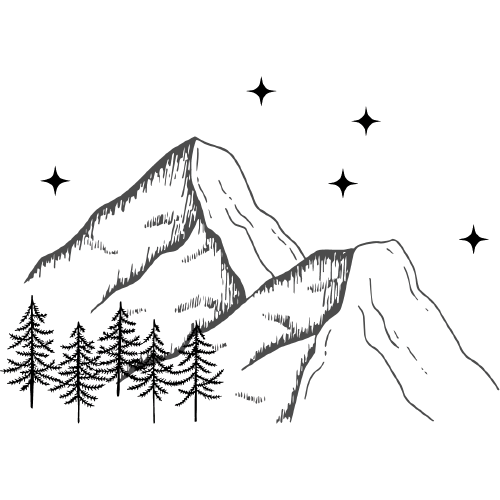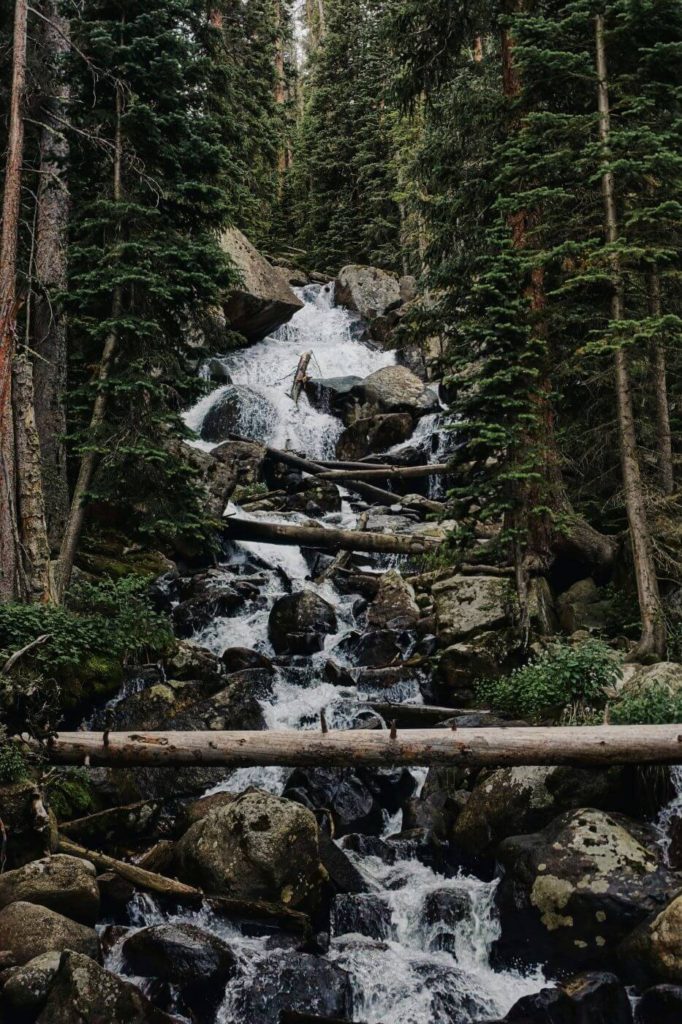10 Easy But Gratifying Hikes in Rocky Mountain National Park
Looking for easy hikes in Rocky Mountain National Park?
Whether you’re hiking with kids or just don’t want to push yourself at the park’s low-oxygen elevation, easy trails are the way to go for many people visiting the Rocky Mountains.
But while there are plenty of epic, lengthy trails in Rocky Mountain National Park, it’s more difficult to find information on the easy hikes in this park.
I had trouble finding easy hikes that I’d be comfortable taking when I was planning my first visit to Rocky Mountain National Park. I compiled this list of easy trails in the park so you don’t have to scour the internet when planning your own trip to this bucket list destination.
All of the trails on this list are less than 5 miles roundtrip and under 1,000 feet of elevation gain.
Ready to pick a trail? Here are 10 easy hikes in Rocky Mountain National Park.
Easy Hikes in Rocky Mountain National Park
Note: As of this writing, if you’re interested in any of the trails along the Bear Lake Road Corridor you’ll need to secure a timed entry reservation that grants access to the corridor in addition to a timed reservation to enter the national park.
I’ve put together a map of easy hikes in Rocky Mountain National Park to make it even quicker to identify trails you may want to take. Continue reading to learn more about each trail!
1. Lily Lake Loop
- Distance: 0.8 mile loop
- Elevation gain: 10 feet
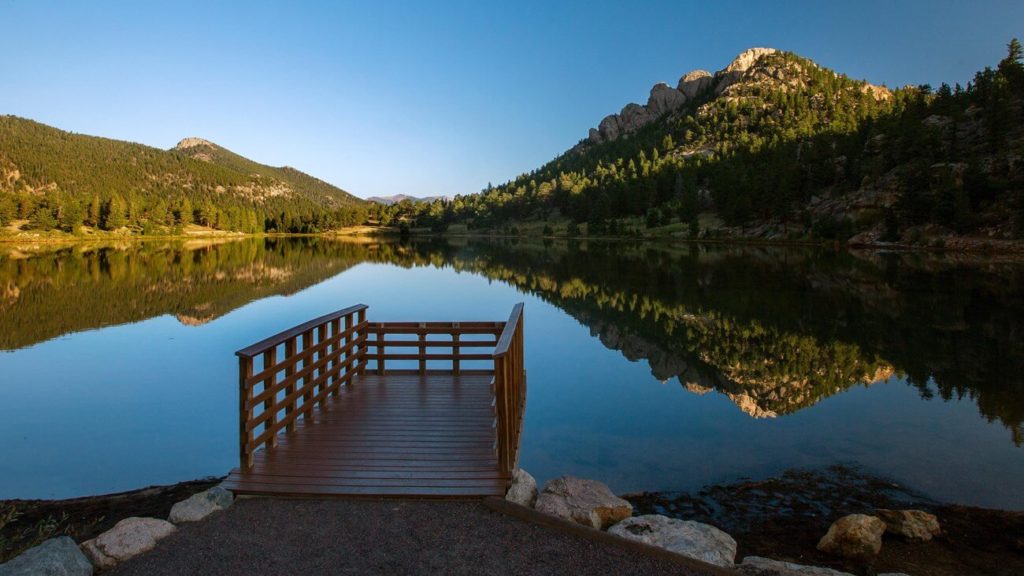
The Lily Lake Loop is a very easy hike that’s good for little kids and anyone needing wheelchair access.
Despite being one of the easier trails in the park, this path still offers excellent views of the Rockies.
Lily Lake is located south of Estes Park and the national park’s main entrances. The lake is right near the eastern edge of the park along Highway 7.
The flat path around Lily Lake is made up of fine gravel and wooden boardwalks.
Along the way, hikers can admire some of Rocky Mountain’s well-known peaks including Longs Peak, Meeker Mountain, and the Twin Sisters Mountain.
Plenty of small wildlife may be spotted, too. A variety of birds, rodents, snakes, and salamanders are drawn to the waters of Lily Lake.
Hikers can make this loop slightly longer by veering off to the Lily Ridge Trail instead of staying on the path that hugs the lakeshore.
2. Tundra Communities Trail (aka Toll Memorial Trail)
- Distance: 1 mile roundtrip
- Elevation gain: 200 feet

The Tundra Communities Trail may be short, but there are several good reasons to take this easy hike.
Visitors who are driving along the park’s famous Trail Ridge Road have the opportunity to stretch their legs and get a short introduction to hiking at high elevation.
Signs along the paved path teach visitors about the tundra environment.
But what may be the biggest appeal of all is the wide-open views of Rocky Mountain’s rugged alpine ecosystem.
The expansive views make this a nice place in the park to watch the sun set.
The Tundra Communities Trail begins at Rock Cut. Rock Cut is a parking area just a bit west of the Forest Canyon Overlook.
Enjoy taking in the views of the Rockies from outside of a vehicle.
The Tundra Communities Trail is also known as the Toll Memorial Trail because of a plaque that’s located at the end of the trail. The memorial is dedicated to Roger Toll, one of the former superintendents of Rocky Mountain National Park.
Wildlife may also be seen among the expansive views on this trail. For me, seeing elk was one of the highlights of hiking this easy trail.
3. Alberta Falls
- Distance: 1.2 miles roundtrip
- Elevation gain: 160 feet
For an easy hike to a waterfall, check out Alberta Falls.
This lovely gravel trail descends through the forest until it reaches the 30-foot waterfall. Make sure to save some energy for the return trip since it is in the uphill direction.
Note that the trail continues past Alberta Falls to connect to a network of other trails. These trails lead to more of the park’s lakes including The Loch and Mills Lake.
If you want to keep this to an easy hike, though, skip the lakes and turn back to the trailhead after admiring the waterfall.
The trail to Alberta Falls begins at the Glacier Gorge Trailhead. This trailhead is just up the road from the iconic Bear Lake.
Alberta Falls is one of the many crowded trails that visitors flock to along the Bear Lake Road Corridor, so consider taking the park’s free shuttle to avoid the madness of finding parking.
4. Bierstadt Lake
- Distance: 2.8 miles roundtrip
- Elevation gain: 560 feet

The trail to Bierstadt Lake is short but steeper than other easy hikes in Rocky Mountain National Park.
If you’re looking for an ultra easy trail in the park, this may not be the ideal choice.
But if you’re up for climbing up some switchbacks, you’re in for some pretty views.
The trail starts out in the forest before opening up to mountainous vistas. The scenery helps distract from any potential discomfort of the uphill climb.
Eventually, the trail levels off as it loops around Bierstadt Lake. Enjoy the relief as you make your way to the spur trail that leads to the lakeshore.
The shallow lake is backed by the beautiful Rocky Mountains. When the water is motionless on a calm day, the lake perfectly reflects its mountainous backdrop.
To find Bierstadt Lake, head to the Bierstadt Lake Trailhead along the Bear Lake Road Corridor.
5. Green Mountain Trail to Big Meadows
- Distance: 3.6 miles roundtrip
- Elevation gain: 600 feet
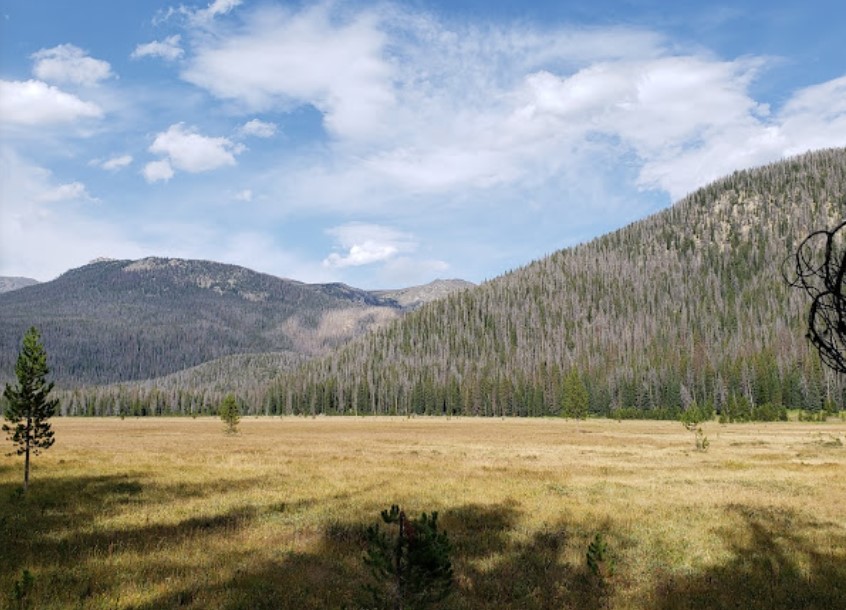
Many of the popular Rocky Mountain highlights are on the eastern side of the park. Therefore, many of the park’s trails are found here too.
If you’re looking for an easy hike on the west side of Rocky Mountain National Park, take the Green Mountain Trail to Big Meadows.
The Green Mountain Trailhead is 3 miles north of the Kawuneeche Visitor Center.
From the trailhead, hikers climb through an area that unfortunately was burned in 2020. Set your expectations for the scenery accordingly.
Admire the large meadow surrounded by beautiful mountains before turning back and returning the way you came.
6. Emerald Lake
- Distance: 3.6 miles roundtrip
- Elevation gain: 600 feet
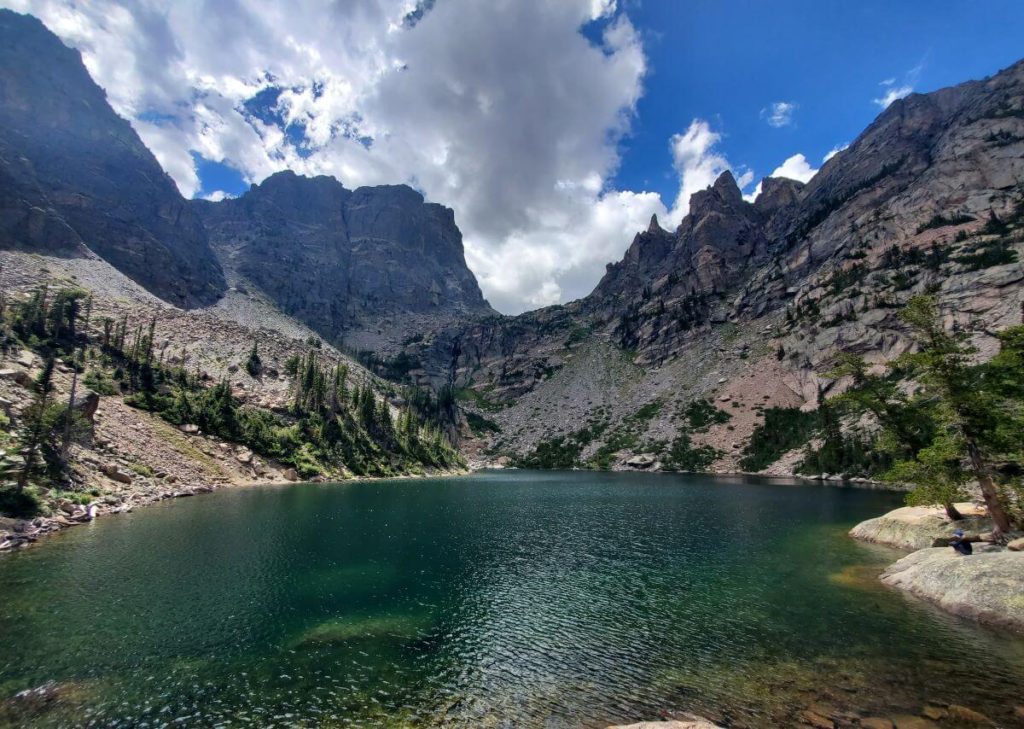
If you only have time for one easy hike in Rocky Mountain National Park, make the hike to Emerald Lake.
The only reason anyone should skip this hike is if crowds will ruin your enjoyment of the breathtaking scenery.
The trail to Emerald Lake is incredibly busy, but it’s popular for a good reason.
This trail leads to not just one but three phenomenal mountain lakes: Nymph Lake, Dream Lake, and Emerald Lake. The aptly-named Dream Lake and Emerald Lake are so beautiful they consistently make lists of top things to do in this park.
If the trail is too long or too crowded for your liking, you can easily turn around at one of the earlier lakes and still have a rewarding easy hike.
Emerald Lake is one of the popular trails in the Bear Lake Road Corridor. Start at the Bear Lake Trailhead whether you risk driving there yourself or take the park’s free shuttle.
7. Calypso Cascades
- Distance: 3.6 miles roundtrip
- Elevation gain: 700 feet
Hikers looking for an easy trail away from the main area of Rocky Mountain National Park should consider seeing Calypso Cascades via the Wild Basin Trail.
Calypso Cascades is in the southeast corner of Rocky Mountain National Park.
Note that the Wild Basin Trail is a bit difficult to access not just because it’s far away from the park’s highlights, but because the road to the trail is rough. Take caution driving on the winding gravel road that leads to the trailhead.
Follow signs for Calypso Cascades along the Wild Basin Trail.
The trail parallels the North St. Vrain Creek.
Hikers will pass several small cascades on the way to Calypso Cascades. But don’t worry, the main waterfall is labeled so you’ll know when you’ve reached it.
8. Ute Trail to Timberline Pass
- Distance: 4 miles roundtrip
- Elevation gain: 460 feet
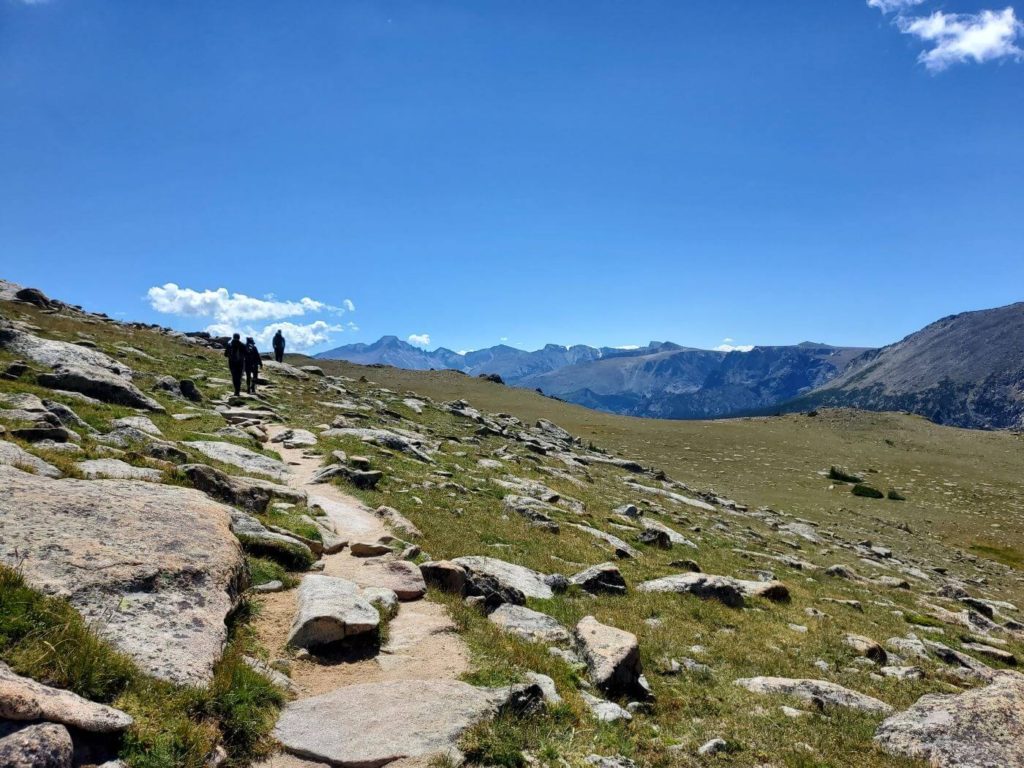
Customizing the Ute Trail to be an easy out-and-back hike takes some attention to detail.
The entire Ute Trail is long and descends steeply to Beaver Meadows, but hikers can simply take the Ute Trail to Timberline Pass for an easier hike.
This stretch of the trail is much more level and short while still letting hikers experience the best of the Ute Trail.
The Ute Trail begins along Trail Ridge Road in between Rainbow Curve and the Forest Canyon Overlook. It is only marked by a sign that describes the history of the trail, so it may be easier to find by looking for the line of cars parked along the road.
This entire section of the trail cuts through alpine tundra, which means that hikers are treated to sweeping mountain views the entire time.
The downside of this exposure is that the trail is cold and windy. Bundle up!
The scenery and lack of elevation gain make this easy trail worth the chill.
It’s likely that you will see wildlife on this trail, too. I saw plenty of adorable marmots and some elk off in the distance.
You’ll reach Timberline Pass after about two miles. The pass isn’t labeled, but you’ll know you’re there when you can see the valley below you and a lone rock outcropping off to the side.
Turn around here or any time before this if you don’t want to hike all four miles to get there and back.
9. Lake Haiyaha
- Distance: 4.2 miles roundtrip
- Elevation gain: 745 feet

Lake Haiyaha is one of many great lake hikes in Rocky Mountain’s Bear Lake Road Corridor. It’s a great choice if you’re looking for an easy-moderate lake hike.
Lots of photos and videos show Lake Haiyaha with dazzling turquoise water like the lakes of North Cascades National Park. This is because a rock slide deposited rock particles into Lake Haiyaha in 2022, but normally the lake’s waters are crystal clear.
To reach Lake Haiyaha, start at the Bear Lake Trailhead and head to Nymph and Dream Lakes as if you were going all the way to Emerald Lake.
Once you’re near Dream Lake, take a detour at the sign for Lake Haiyaha.
Take in the spectacular sights of the Glacier Basin landscape along the remainder of the trail.
Note that this trail includes a few narrow bridge crossings. Additionally, Lake Haiyaha is surrounded by boulders that you’ll have to clamber over and around to reach the lakeshore.
10. Cub Lake
- Distance: 4.6 miles roundtrip
- Elevation gain: 540 feet

Cub Lake is a good trail for hikers who are ok visiting a less picturesque lake in exchange for a less crowded trail.
Cub Lake is in the Bear Lake Road Corridor section of Rocky Mountain National Park. The trail starts west of Moraine Campground along Fern Lake Road.
The beginning of the hike offers splendid views of a mountain-lined meadow as the trail follows the western edge of Moraine Park.
After this, the trail turns into a steeper and rockier path. It also goes through a landscape that was burned in a fire in 2012.
Appreciate the trail for the experience of hiking among fewer tourists, not for magical bucket list views, and this easy hike will be worthwhile.
Tips for Hiking in Rocky Mountain National Park
The high elevation of Rocky Mountain National Park creates unique conditions that even experienced hikers may not be prepared for. Here are some key things to know to prepare for hiking in this park.
- Thunderstorms are common in Rocky Mountain National Park and they can appear without much warning. Storms are more common in the afternoon so aim to hike in the morning if your timed entry permits allow it. Keep an eye out for dark clouds and return to the trailhead if you hear thunder.
- There is less oxygen in the atmosphere at higher elevations. If you’re not used to hiking at Colorado’s high elevation, altitude sickness can happen even on easy hikes. Go slowly and take lots of breaks.
- The alpine vegetation that thrives at this altitude is fragile. Stay on trails to prevent damaging the ecosystem’s sensitive plants.
Need more help planning your trip to Rocky Mountain National Park? Check out these related articles:
- The Best Campgrounds In (And Near) Rocky Mountain National Park
- 7 Places to Catch a Rocky Mountain National Park Sunset
- How To Plan A National Park Trip: 7 Tips For A Perfect Visit
As always, enjoy the outdoors responsibly. Leave no trace on all of your adventures.
